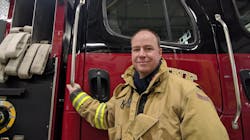Public Service Motivation: Interview Questions for Prospective Members
As the recruitment and retention crisis continues in the volunteer fire service, it is vital for volunteer fire departments to recruit members for the long-term.
The most recent survey conducted by the National Fire Protection Association (NFPA) showed a 20% decline in active members from 2015-2017. The survey estimated the number of volunteer firefighters nationwide at 682,600; the lowest number since the reporting started in 1986.
Volunteer fire service leaders must develop long-term retention strategies that focus on recruiting intrinsically motivated members that will become future leaders. Recruit your successor. It is a difficult thought process, but it has become necessary. The start of that succession plan begins with recruiting prospective members with an internal drive to serve the citizens of their respective community.
Public service motivation (PSM) is a framework for studying the internal motivations that drive individuals to join volunteer organizations. The model was developed by Dr. James Perry and includes four motivational traits: policy making and politics, public interest or civic duty, compassion, and self-sacrifice. This form of motivation originates from the beliefs and motives that are found within individuals who serve in the public domain.
Perry concluded that an individual’s PSM develops over time and incorporates a wide variety of experiences. Since the original Perry model was introduced, researchers have contributed by making changes in the model for more simplification using only one or two of the dimensions noted in the original study.
Recruiting new members requires a process of moving individuals through a series of phases. They may be completely unaware of what the volunteer fire service does or how it provides service to a community. They may have family or friends that volunteer. Providing prospective members with an application packet moves them into the interview phase of the recruitment process.
The interview set-up is different in each department. It may include only one interviewer or be set up as a panel. It is important to have questions that are designed to find out what kind of values and motivations a prospective member possesses. A recent study that included interviews with former volunteer fire members concluded that 80% of those interviewed did not have PSM when joining the fire department. They were recruited based on family legacy, friends, or responding to a recruitment drive such as mailing or flyer.
Disenfranchisement with department leadership, group dynamics, and lack of time were the primary reasons for leaving the fire department. Organizational issues plague all volunteer fire departments. Members with strong PSM factors are much more likely to work through departmental issues because they have internal motivations that will keep them going despite leadership problems and/or group dynamic issues.
A list of potential PSM related questions is provided below:
- Why do you want to join our organization?
- What are your short-term and long-term goals?
- How can you give back to the community?
- What, in your experience, motivates you to be successful in job performance?
- How do you maintain your personal level of motivation?
The responses provided will help determine the level of PSM in the prospective member. It boils down to determining the motivational factors, if any, that exist within the prospective member. The values that the prospective member displays should fit into the fire department cultural environment.
Listen carefully and take notes during the interview. Do the answers provided reflect a drive to serve the community, a desire to be a productive community servant, a sense of compassion for people that need assistance along with a willingness to provide aid when called? Pay particular attention to answers that reflect motivational traits that are intrinsic and also on the negative side to those that display extrinsic values, such money or status.
A prospective member that displays PSM is an individual that has potential long-term retention and should be viewed as such during the first year of service. Since these members are coming in with an internal drive it does not need to be provided for them. To foster that PSM, leaders need to keep clear lines of communication open, provide feedback and coaching, treat members with respect, apply fire department rules fairly and consistently, and involve members in the policy making process.
The goal of the volunteer fire service must be recruitment for the long-term. It is the only way that volunteer fire departments are going to survive over the next 20 years. Recruit the successors and future leaders of the fire service. Most importantly, use their internal PSM to foster growth so that in the years to come they become the leaders that will propel the volunteer fire service forward in the decades to come.
The interview phase is one of the most important components of bringing a prospective member into the volunteer fire service. It provides both parties with the opportunity to see if the organization is the right fit. By developing PSM related questions, the interviewer or interview panel will be able to determine the level of PSM within a prospective member.
NFPA statistics paint a very scary picture and the only way to ensure an increase in those numbers during the coming years is a focused effort on long-term recruitment and retention strategies. Discover the members that will provide a bright and sustainable future for the fire service. Recruit your successor.
About the Author

Jason Decremer
Jason Decremer, PhD, is the director of Certification for the Connecticut Commission on Fire Prevention and Control. He is responsible for over 35 levels of national certification testing for approximately 30,000 firefighters statewide. Decremer has been a member of the volunteer fire service for nearly 20 years. He also is an adjunct professor at the University of New Haven and Goodwin College, teaching courses in Homeland Security and Fire Administration. He received his PhD in public policy and administration from Walden University and a master’s degree in curriculum design and education from the University of Phoenix.
